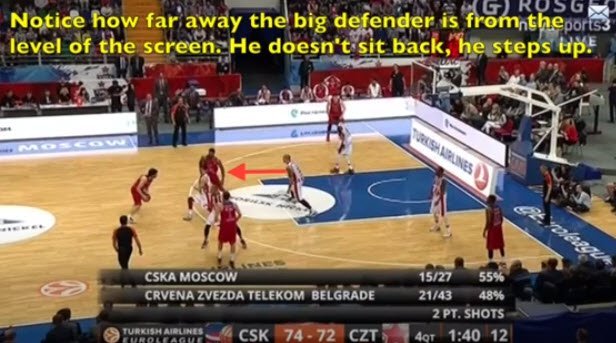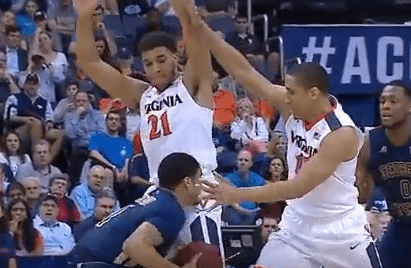Ball Screen Half-Court Basketball Defense by John Zall
The Ivy League is as competitive as it ever has been with good college basketball teams throughout the league. Harvard won the league again and won a game in the NCAA Tournament. The four teams that finished 2nd-5th respectively were separated by only 2 games and all finished with records of .500 or better in conference play.
The Brown University Bears finished the season with a record of 7-7 in conference play and a 15-14 record overall. This record placed them just two games behind 2nd place Yale and one game behind Princeton and Columbia who tied for 3rd place.
The strength of Brown’s team this year was unquestionably their basketball defense, which compared favorably to some of the best defensive teams in the country. Opponents scored at a rate of .961 points-per-possession(PPP); good for 26th in the country out of 351 Division I teams.
Scoring was at a premium because teams couldn’t get good shots against Brown’s basketball defense. Opponents shot 39.4% from the field against them, 15th in the country, and only 30% from three point range, 13th in the country. Effective field-goal percentage (eFG%) is a stat that calculates a teams’ field-goal percentage, but three-point shots are factored in to the equation and given slightly more weight because they are worth more on the scoreboard than a regular two-pointer. Brown held its’ opponents to an eFG% of 44.2% ranking 13th in the country.
I know what thought might be running through your mind: “Brown plays in the Ivy League and probably plays a slow style.” That actually couldn’t be further from the truth. During a Brown University basketball each team (Brown and their opponent) averaged 69 possessions per game. That number is good enough for 59th fastest pace in the country. So in other words, Brown was giving you a lot of possessions to score and their opponent still struggled mightily.
Solid and well defined principles were the backbone of the Brown basketball defense for the 2013-14. This was never more evident than in their ball-screen basketball defense. Opponents ran ball screens 11.5% of the time against Brown according to Synergy. When running ball-screens, opposing teams scored at a paltry rate of .579 PPP; good for 6th in the country.
The following YouTube video is a small sample size of the Brown ball-screen basketball defense. As you will see, Brown sticks to a strict set of principles when defending the ball screen. With any ball-screens in the middle of the floor, the defender guarding the ball with go over or under the screen depending on personnel. The defender guarding the screener will usually be positioned at the screeners bottom foot or one step below. The defender guarding the screener will hedge for one or two dribbles, just long enough for the defender guarding the ball to “square it back up.” Squaring the ball up is when the defender is able to get back in front of the ball-handler. Brown’s guards are excellent at being physical with the ball-handler, moving their feet and squaring the ball back up.
Any ball-screen that is on the side of the floor Brown will “ICE” or “Down” it. This coverage originated in the NBA and has become very popular in college. When a side-ball screen is about to be set the defender guarding the ball jumps above the screen and faces the sideline, prohibiting the ball-handler from using the screen and getting to the middle of the floor. The defender guarding the screener drops below the screen and corrals the ball-handler as he is being forced to the baseline. Often times the screener will usually “flare” to the perimeter and not roll to the hoop for spacing purposes. If this occurs, help on the screener comes from the defender guarding one-pass away on the perimeter; usually positioned at the free throw line area.
In the final clip you’ll see Yale run what is called a “twist”, another common NBA action where the ball-handler comes off one ball-screen then comes off another and changes direction again. The defender guarding the ball goes under ball while the screeners’ defenders stayed attached and rotated back to close out.
John Zall BIO
Coach John Zall just completed his first season as an Assistant Coach at Division II Franklin Pierce University in Rindge, NH. This past season Franklin Pierce University won 20 games and advanced to the 2nd round of the NCAA Tournament. Zall arrived at Franklin Pierce after spending the past 3 seasons as the Associate Head Coach/Head JV Coach at O’Bryant High school in Roxbury, MA. During his tenure at O’Bryant the program improved from 4 wins to 12 wins and qualified for the MIAA State Tournament twice.
Coach Zall also has experience as an AAU Head Coach for the Boston Warriors. As Head Coach for the Warriors his team won the 2011 16U State Title and twice competed in AAU Nationals down in Orlando, FL. On top of being a student at Northeastern University, Zall was named Head Coach of the Men’s Club Basketball team for the 2012-13 season. During his lone season as Head Coach, Northeastern finished second in the Northeast Regional Tournament featuring colleges from throughout the East Coast. Coach Zall has also spent time as a Head Coach in the Bay State Games where his team won the Bronze Medal in 2012 and at various camps including: Five Star, Boston Celtics, NIKE, Franklin Pierce University, Hoop Group and The Elite 75.






0 Comments